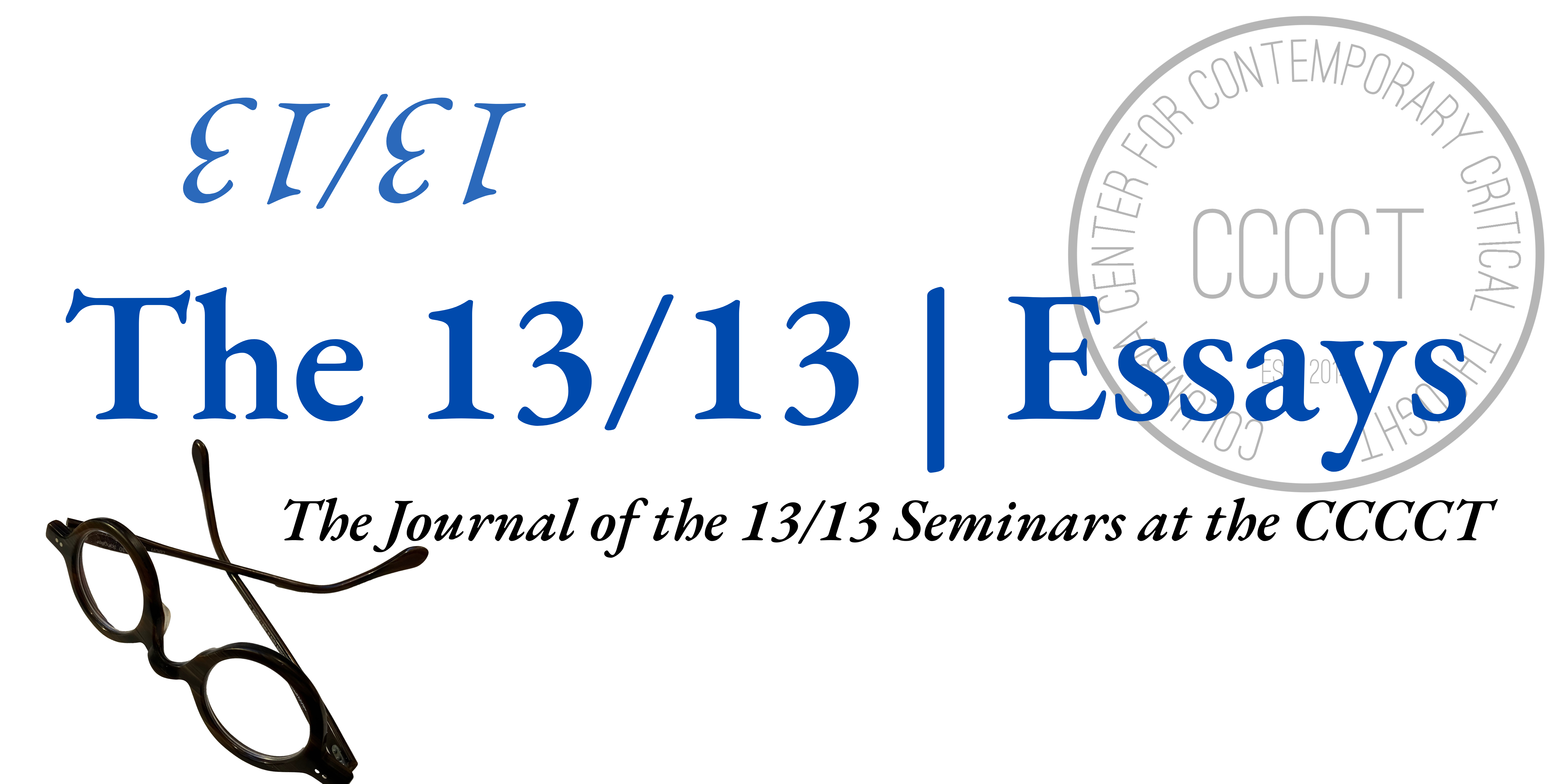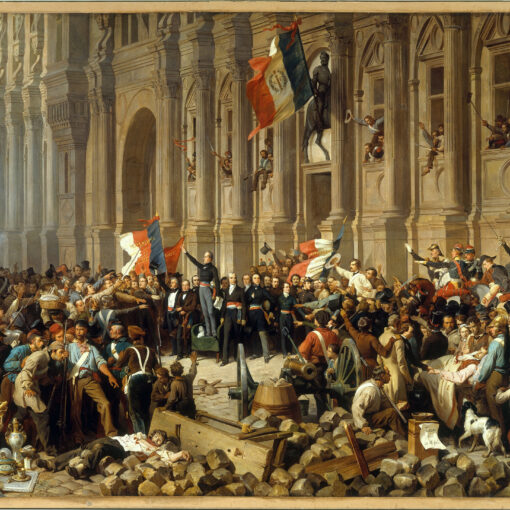Chapter 1
Critique of the International Division of Intellectual Labor
by Bruno Bosteels
*** PLEASE DO NOT CIRCULATE WITHOUT WRITTEN PERMISSION FROM THE AUTHOR ***
NB: This is Chapter 1, “Critique of the International Division of Intellectual Labor,” from Mexico in Marx, Marx in Mexico, Part II of The Mexican Commune (forthcoming with Duke University Press, translated by the author from the Spanish edition, La comuna mexicana, Mexico City-Madrid: Akal, 2021-2022).
The idea behind this second part is that a return to some of Marx’s lesser-known texts may help us articulate the links that exist between the commune as modern political form or strategy, typically associated with the heroic case of the Paris Commune, and the community or communality as forms of life with deep roots, especially in Latin America, in indigenous uses and customs that otherwise are alien or even opposed to the dream of Western modernity. Without pretending to be exhaustive, the aim is to propose a series of working hypotheses for the articulation of commune and community. To this day, however, such an articulation continues to face the obstacle of a series of divisions of intellectual labor, which contribute to the unfortunate missed encounter between Marx’s critical thought and Mexico’s historical realities.
In the first place, this reading presupposes a displacement of our focal point from a canonical text such as Capitaltoward Marx’s posthumous texts, like the ones published beginning in the 1970s in the Ethnological Notebooks, in Late Marx and the Russian Road (the latter were the topic of Marx 11/13 with Kohei Saito), or, even more recently, in the Bolivian anthologies Escritos sobre la comunidad ancestral and Colonialismo: Cuaderno de Londres No. XIV. Something that from within Latin America may appear as a familiar terrain, though, is not as well-known in Marxist theory in general, where until a decade or two ago there appears to be only scant interest in fostering a dialogue, for example, about the immanent links between Capital and the Ethnological Notebooks. Even within a single posthumous publication like the Grundrisse: Foundations for the Critique of Political Economy, first published in Moscow in 1939 before receiving an uptick in fervent appreciations in the 1960s and 1970s in Italian thought after the example of Antonio Negri (the topic of Marx 9/13 with Sandro Mezzadra and Michael Hardt), we can observe a clear division of labor in the production of knowledge, insofar as the majority of European interpreters of Marx prefer to place their focus either on the methodological “Introduction” (the famous Einleitung of 1857) or on the so-called “Fragment on Machines,” whereas his Latin American readers, including in Mexico, focus much rather on the historical section on “Forms that precede capitalist production” (also known as the Formen, after its abridged title in German, Formen die der Kapitalistischen Produktion vorhergehen). So long as we do not overcome this division of intellectual labor, in my opinion we will likewise not be able to understand the complex relations between commune and community.
Some will say that what we have here is a simple distinction between fields or disciplines in the social sciences and the humanities. Philosophers and theoreticians are the ones who tend to favor the more abstract, methodological or conceptual texts of Marx, to find in them the philosophy present “in a practical state,” for instance, in Capital, as the Althusserian school pretends to do, whereas historians and anthropologists, by an inverse kind of professional deformation, tend to prefer The Eighteenth Brumaire of Louis Bonaparte or the Ethnological Notebooks. Alternatively, limiting ourselves once again to the Grundrisse, the former turn to the “Introduction” in search of the necessary elements for constructing dialectical materialism as the philosophy of Marxism, whereas the latter believe they can define the tasks of historical materialism as the Marxist science of history on the basis of a section such as the “Forms.”
In other words, the division of labor to be overcome not only is operative between Marx’s canonical and marginal texts, but it also separates the fields of philosophy and history, just as it distinguishes theoretical reflection from empirical investigation. In this sense, we can speak of a second division of labor, which is but a different way of formulating the first, according to the prejudices typical of the different disciplines for producing the intelligibility of our time.
In Mexico, Ángel Palerm attempted to formulate this tension in terms of a double crisis: the crisis of Marxism—both Soviet and Western—under the shadow of Stalin and the crisis of anthropology as a discipline grown ever more self-conscious of having emerged from within a profoundly colonial and Eurocentric endeavor. According to this exile from the Spanish Republic, the dual crisis paradoxically creates an opportunity to rearticulate a productive relationship between anthropology and Marxism. But, for this to happen, we would have to break with the typical division of labor between the two fields or disciplines: “That is to say, between the production of anthropological work, rich in results but generally a-theoretical, empiricist, and eclectic, and Marxist theory, dogmatic and ritualized but still full of vitality and scientific potential.”[1] Nobody can be a Marxist, in this sense, without reestablishing a minimal dialectic between theory and praxis, or between the abstract and the concrete.
On the one hand, as Palerm proposes in “Antropología y marxismo en crisis” (“Anthropology and Marxism in Crisis”), included in the collection Antropología y marxismo, anthropology should expand its preferential option for empirical research and fieldwork on “primitive,” pre-capitalist or non-Western societies: “A restored and renovated form of anthropological research must definitively reject the arbitrary division of labor, which is theoretically and practically unsustainable, that pretended to relegate us to the study of so-called primitive societies.”[2] In this sense, the theoretical contribution of Marxism to anthropology would be fundamental; but, inversely, the Marxist discourse should also learn from the ethnographic work of anthropologists, in order not to remain trapped in the abstraction of grand theoretical systems. “The dissociation of theory-praxis, on the other hand, frequently has turned theoretical experimentation into an academic game, in which intellectual fashions succeed one another with ease, speed, and superficiality,” Palerm observes. He explains: “Of course, theories must be criticized in and of themselves. In any case, we should call attention to the fact that, by distancing itself from praxis, theories tend to be handled like fashions. This always has grave consequences.”[3]As examples, the author mentions the influence of the structuralism of Claude Lévi-Strauss as well as the original attempt of the Althusserian school, in the mid-1960s, to amalgamate structuralism with Marxism against historicism.
However, we face yet another division, or a third way of approaching the same problem of the division of labor as an obstacle to think through the relationship between Marx and Mexico. This is because it is not merely a matter of selecting the most appropriate texts for our thematic within the extended corpus of the German thinker’s intellectual production, nor is it a purely subjective methodological question of finding the perfect equilibrium between theory and praxis, between speculation and fieldwork, or between Marxism and anthropology. Rather, this rarefied separation between, on the one hand, theoretical or philosophical speculation by means of which humanity is supposed to be capable of reflecting about itself, and, on the other, the scientific accumulation of empirical data and raw materials, referring to so-called primitive or non-European societies, is in turn based on a long history that is inseparable from the worldwide colonial and imperialist expansion of capitalism.
Thus, as the Japanese translation theorist Naoki Sakai has suggested, the separation between the West and the rest of the world not only is a geopolitical question, but it also carries with it the assumption of a division in the cognitive and epistemological capacities attributed to different segments of the human population. Only the West, according to this prejudice, would be capable of producing knowledge both on the empirical level and on a second, meta-empirical or transcendental level, typically associated with an ability for theory or philosophy. The rest of the world, by contrast, would remain limited to the first level of knowledge, which provides the theories produced in the great metropolis with the raw materials of their empirical data as well as, after the theories are constituted, with the presumably empty and pristine terrain for their practical application. In this manner, the distinction between types of knowledge—empirical or theoretical—would be correlated with a much more ominous divide within humankind—between the great minds of illustrious geniuses capable of creative self-reflection in the metropolitan center and the mass of individuals condemned to serve as native informants for the extraction of empirical data in the peripheries. Sakai sums up this cognitive-subjective divide in terms of the difference between humanitas, as the idea of the human subject capable of taking itself as object of universal reflection, and anthropos, as the set of all that which belongs to the particularity of the non-Western other. He concludes:
In short, in this epistemic transaction, the West insists on being determined in terms, not of its characteristics as an object of knowledge, but rather its subjective faculties and productivity. Tentatively, let me attribute the name “theory” to these certain subjective faculties and productivity, which distinguish European humanity from other ethnicities, the Western “man” from the Rest of humankind.[4]
Schematically, the epistemic and geopolitical division of intellectual labor on a global scale could be defined according to the following polarities:
HUMANITAS ANTHROPOS
the West the Rest
theories data
universal particular
transcendental empirical
subject object
I am afraid that the discussions about Marx and Marxism in the world also still suffer a great deal from these divisions and polarities. Suffice it to think of how the great philosophers of our time continue to proclaim themselves Marxist but refuse to follow Marx’s own example to enter the debate about “primitive,” precapitalist or non-Western societies. Conversely, we can think of the opposite reaction, which consist in “provincializing” or “decolonizing” Marx and Marxism as part of the tradition of Eurocentric enlightened thought, but without entering the immanent and real logic that ties the thought processes of abstraction and universalization to the expansion of capitalism that did in fact took off from Europe.
The hope behind this second part of the book, therefore, consists in provoking a series of short circuits between Marx and Mexico to help us overcome the multiple divisions of intellectual labor just diagnosed. Its title, “Mexico in Marx, Marx in Mexico,” lays no claim on originality, nor do I pretend to offer great novelties as far as the information about these topics is concerned. On the contrary, in its very predictability, the title serves to signal that among the works readily available about our subject-matter, sometimes with almost identical titles, we can find many elements for a kind of theorization in the act—sweeping up all the aforementioned hierarchies between anthropology and Marxist theory, between history and philosophy, between the empirical and the transcendental, or between the concrete and the abstract—about the articulation of commune and community in Mexico.
On the one hand, in 1939, there appears an anthology of texts under the title México en la obra de Marx y Engels (Mexico in the Work of Marx and Engels), prepared by a certain Domingo P. de Toledo y J. (according to Gastón García Cantú, a pseudonym of the Cuban writer José Antonio Fernández de Castro), published first in El Trimestre Económicoand subsequently reprinted as a small booklet by the Fondo de Cultura Económica.[5] This pamphlet contains a selection of fragments from personal letters, journalistic articles, and canonical works in which Marx and Engels mention certain aspects of the history of Mexico. Most of these fragments refer to the intervention of the United States in Mexico and the negotiations between France, England, and Spain to install Maximilian of Habsburg as emperor of Mexico against the liberal regime of Benito Juárez. Later, in 1972, these fragments from the anthology of Domingo P. de Toledo y J. would be incorporated into a much larger volume of selections from Marx and Engels, Materiales para la historia de América Latina (Materials for the History of Latin America) edited by Pedro Scaron for the series Cuadernos de Pasado y Presentedirected by José M. Aricó, first in Argentina and then during the latter’s exile in Mexico.
On the other hand, also in 1972, José Porfirio Miranda publishes a short book titled Marx en México: Plusvalía y política (Marx in Mexico: Surplus Value and Politics), in which he adopts the model of Marx’s analysis in The Eighteenth Brumaire of Louis Bonaparte to argue that the bourgeoisie in Mexico at last would have learned the lesson that it was much more preferable for the dominant class not to dominate directly but through the delegation of the governmental functions in the hands of a technocratic elite as its shadow puppet or representative intermediary. As such, the study presents itself as openly theoretical with the intent of overcoming the political inefficacy of Marxism in Mexico: “The inefficacy that has accompanied the revolutionary praxis of Mexican Marxism must, in good Marxist fashion, be explained based on failures in the theory, from within the theoretical analysis itself.”[6] At the same time, the author seeks to put into practice the Marxist method to study the new configuration of power in Mexico after 1968, with the so-called democratic opening under President Luis Echeverría: “The present book is an attempt to apply to Mexico the Marxist relation between economic base and political superstructure. The aim is for this thesis to acquire its cognitive value from reality, but by giving it depth and precision by way of a rigorous exegesis of Marx’s works, all of which connects our study of Mexico to the worldwide investigation of Marxism.”[7] Marx en México, in this sense, proposes to analyze the Mexican situation finding inspiration in the model used by Marx himself, when in The Eighteenth Brumaire he explains that for the bourgeoisie of the Second Empire in France the farce of the Napoleonic regime constitutes henceforth the normal form of political power: “The whole state-oriented and ‘democratic’ maneuver under capitalism is in essence a ruse: a ruse of such effectiveness that it convinces even its own protagonists; but the essence of the ruse consists in dissociating economic domination from political domination.”[8] For the author, such would have been the secret of the regime of the PRI in its more than thirty years since the presidency of Lázaro Cárdenas.
If México en la obra de Marx y Engels provides us with numerous empirical materials, Marx en México serves as an example for how to combine theoretical speculation with the historical analysis of the country’s concrete realities. What none of the authors or editors of these prior works could have known in their time is that the interest Marx shows for Mexico by no means remains limited to his journalistic work about the period of post-independence. Nor can they be blamed for ignoring the fact that, if in his own work the German thinker dedicates himself to discuss the ancient Mexico of pre-Cortesian times, this happens not only in the “Forms” in the Grundrisse or in the section on primitive or originary so-called accumulation at the end of Volume One of Capital but also in his London Notebooks or his Ethnological Notebooks, which would not be published until after the first editions of México en la obra de Marx y Engels, Marx en México, or Materiales para la historia de América Latina already had been printed.
In his introduction to this last anthology, the editor Scaron proposes to distinguish four stages in the treatment of Latin America in the thought of Marx and Engels:
- From 1847 until approximately 1856, when Marx and Engels in The New York Daily Tribune, among other journalistic publications, seem to find theoretical and political justifications for colonialism, even if on moral grounds they condemn the atrocities being committed.
- From 1857 until the founding of the International in 1864, when the authors show a growing consciousness of the abuses suffered by the ex-colonies and peripheral nations in the world, all while defending their shared right to self-determination.
- From 1864 until Marx’s death in 1883, when the author of Capital shows a growing interest in understanding the national question and openly supports the cause of independence for countries like Ireland or India.
- A fourth period, limited to the aging Engels during his final twelve years after Marx’s death, when he picks up many of the materials from his friend’s notebooks to compose works such as The Origin of the Family, Private Property, and the State.[9]
The same editor summarizes the change in perspective between the first two and the last two of these stages as follows:
The classics of Marxism go from a categorical and enthusiastic support for North American expansion, in the stage that we have tentatively and approximately dated between 1847 and 1856, to its criticism in the period that goes, more or less, from 1856 to 1864. In 1861 and subsequent years Marx resolutely opposes the Anglo-French-Spanish intervention in Mexico, but it is still significant—and typical of the period that concerns us—that the exclusive basis of his criticism of the interventionists is something as little “Marxist”, or if you want as little specifically “Marxist”, as the old law of nations.[10]
About the final two stages, on the other hand, Scaron admits to not having as many materials at his disposal as he would like. This is because in 1972 there still exists no edition of those writings in which Marx repeatedly gives proof of his profound interest in the socioeconomic realities of ancient Mexico. Even more important than the presence of data is the fact that these investigations of the late Marx, when he draws an overview of the broad historical and ethnological bibliography that includes authors such as Lewis H. Morgan on Aztec society, allow him dramatically to transform the presuppositions of his own philosophy of history that in his younger years had led him to celebrate, at least up to a certain point, the “beneficial” consequences of the conquest and colonization of Mexico and Latin America.
In this context, once again, we can confirm the importance of not falling in the trap of separating Marxism from anthropology, or theoretical-speculative work from historico-material research. As Palerm concludes:
I think it can be said that the influence of anthropology contributed powerfully to taking Marx out of his Euro-Western box, opening up to him the panorama of the varied development of the world’s civilizations. If we also accept the idea that it was during this period of ethnological readings that Marx transformed the unilinear evolutionary conception, based on European historical experience, into a conception of universal and multilinear nature, we will have to appreciate even more decisively the influence of anthropology on Marxism.[11]
Refusing to situate the premises of Capital in the larger context of the world history of peoples and nations that are the objects of Marx’s research in his Ethnological Notebooks not only means ignoring a considerable part of the German thinker’s intellectual trajectory—something which in and of itself constitutes a curious way of proceeding, especially for philosophers and theorists who take great pains to abandon the humanism of the “young” Marx in favor of the scientific rigor of the “mature” Marx, but who at the same time show little to no interest in the investigations of the “late” Marx. It also means skipping an unmistakable chance to appreciate how this trajectory toward the end of this old communist’s life becomes majorly disrupted and even begins to submit itself to a noticeable self-criticism.
Within the limits imposed by the lack of documents available at the time, the confrontation with Mexico’s realities proved instrumental for Marx in his change of perspective from a Hegelian, teleological, and unilinear philosophy of history toward a more discontinuous and multilinear outlook. This is why it turns out to be so illuminating to study to what extent the German thinker, even if his European readers rarely follow him in this initiative, tried to deepen his material and not merely speculative grasp of the history of Indigenous peoples—including the Aztecs—to elaborate, based on these readings, his own thought about the future of the commune. Others, like Teodor Shanin in Late Marx and the Russian Road, have discussed this for the case of the obshchina or the mir of the Russian agrarian commune, just as José Carlos Mariátegui in his 7 ensayos de interpretación de la realidad peruana had done so for the ayllu in the Andean region. But much remains to be done to put together the pieces of the rompecabezas that is the puzzle or, literally, the “head-breaker” that Marx himself was composing when in the final years of his life, after the Paris Commune, he briefly took up the historical and ethnological study of the calpulli in ancient Mexico.
Among the so-called peripheries of the capitalist body, in fact, Marx always had a special interest in Mexico. While his and Engels’s support for the US invasion of Mexico in 1846-1848 long overshadowed this part of his investigations, the late Marx would devote some of his most fascinating Ethnological Notebooks to the interpretation of precapitalist economic formations and kinship structures among the Aztecs. In fact, more than two decades before he would copy and annotate long parts of the chapter on “The Aztec Confederacy” from Lewis H. Morgan’s 1877 Ancient Society, already in the 1850s William H. Prescott’s The Conquest of Mexico had given Marx access to the notion of the calpulli, which forms the basis for a long underground history of communal revolts, all the way to Emiliano Zapata during the Mexican Revolution. Marx thus provides us with the materials for an alternative history and theory of the commune, independently of the 1871 Paris Commune.
Notes
[1] Ángel Palerm, Antropología y marxismo (first edition, 1980; Mexico City: Centro de Investigaciones y Estudios Superiores en Antropología Social/Universidad Autónoma Metropolitana/Universidad Iberoamericana, 2008), 45. See also the materials gathered in the collective volume, Marxismo, antropología e historia (y filosofía), ed. Miguel Ángel Adame Cerón (Mexico City: Ediciones Navarra, 2011).
[2] Palerm, Antropología y marxismo, 70.
[3] Ibid., 68. This judgment did not stop a Mexican anthropologist like Mercedes Olivera from considering the work of Palerm, together with that of Roger Bartra on pre-Hispanic Mexico, part of a “theoreticist” tendency that contrasts with another tendency, focused on gathering basic information data but without any theoretical position: “It is necessary fully to develop a position that would combine both tendencies in a systematic form,” in Pillis y macehuales: las formaciones sociales y los modos de producción de Tecali del siglo XII al XVI (Mexico: Ediciones de La Casa Chata/Centro de Investigaciones Superiores del INAH, 1978), 16. On Olivera’s own trajectory, see Marisa G. Ruiz Trejo, “Aportes a la antropología feminista en Chiapas: Entrevista a Mercedes Olivera,” Abya Yala 2.1 ( 2018): 209-27.
[4] Naoki Sakai, “Theory and the West: On the Question of Humanitas and Anthropos,” in the online journal Transeuropéennes: International Journal of Critical Thought (2011). On the uneven exchange of ideas in a globalized world that risks prolonging the colonialism of anthropological knowledge through ethnographic work at the expense of its native informants, see also June Nash, “Ethnographic Exchanges in Global Spaces,” in Ethnographic Collaborations in Latin America: The Effects of Globalization, ed. June C. Nash and Hans C. Buechler (New York: Palgrave Macmillan, 2016), 221-35. Like Palerm, Nash also refers to the warning sign that was the volume Anthropology & the Colonial Encounter, ed. Talal Asad (Atlantic Highlands: Humanities Press, 1973), but she adds that the subsequent emphasis on the anthropologist’s own interpretive authority as reader of texts, rather than artefacts, as in the papers for the volume Writing Culture: The Poetics and Culture of Ethnology, edited by James Clifford and George E. Marcus (Berkeley: University of California Press, 1986), perpetuates the exclusion of women and Indigenous voices based on a dichotomy between the theory from the North and the “raw materials” of its occluded and silenced sources from the global South.
[5] Domingo P. de Toledo y J., “México en la obra de Marx y Engels”, El Trimestre Económico, vol. 6.21- 1 (April-June 1939): 84-140; México en la obra de Marx y Engels (Mexico City.: Fondo de Cultura Económica, 1939). See also Gastón García Cantú, “México y Marx,” in El socialismo en México: el siglo XIX (Mexico City: Era, 1969), 187-98. The hypothesis about the pseudonym of José Antonio Fernández de Castro appears in this last chapter, 464 n. 1.
[6] José P. Miranda, Marx en México: plusvalía y política (first edition 1972; Mexico City: Siglo Veintiuno, 1973), 3.
[7] Ibid., 4.
[8] Ibid., 21.
[9] Scaron, “A modo de introducción”, in Materiales para la historia de América Latina, 6-11.
[10] Ibid., 11.
[11] Palerm, Antropología y marxismo, 51. On this change in perspective in the final Marx, see Late Marx and the Russian Road: Marx and the ‘Peripheries of Capitalism,’ ed. Teodor Shanin, (New York: Monthly Review Press, 1983); Kevin B. Anderson, Marx at the Margins: On Nationalism, Ethnicity, and Non-Western Societies (Chicago: University of Chicago Press, 2016); Harry Harootunian, Marx after Marx: History and Time in the Expansion of Capitalism (New York: Columbia University Press, 2015); and Marcello Musto, The Last Years of Karl Marx: An Intellectual Biography (Stanford: Stanford University Press, 2020). More recently, see also the concise summaries of Néstor Kohan, “Marx y las periferias latinoamericanas,” El Cotidiano 210 (July-August 2018): 63-68; and Álvaro García Linera, “Marx y su visión multilineal de la historia,” in Marx, 200 años: Presente, pasado y futuro, ed. Esteban Torres, Elvira Concheiro Bórquez, Félix Valdés García, Matías Bosch Carcuro, Pablo Vommaro and Rodolfo Gómez (n.p.: CLACSO, 2020), 61-78. On the other hand, there is barely any mention, let alone a conceptual elaboration, of Mexico’s case in Kevin B. Anderson, The Late Marx’s Revolutionary Roads: Colonialism, Gender, and Indigenous Communism (London: Verso, 2025).





